written and photographed by Mary L. Peachin
May 2002, Vol. 6 No. 7
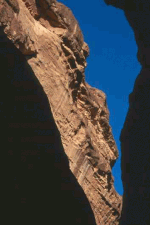 The narrow, winding chasm of the slot canyon, or siq, enveloped me as I wandered down the cobbled limestone path. As I neared the lost city of Petra, the path turned to gravel. I peered into every crevice and niche of the deep rust-colored walls, sometimes catching glimpses through the open slots.
The narrow, winding chasm of the slot canyon, or siq, enveloped me as I wandered down the cobbled limestone path. As I neared the lost city of Petra, the path turned to gravel. I peered into every crevice and niche of the deep rust-colored walls, sometimes catching glimpses through the open slots.
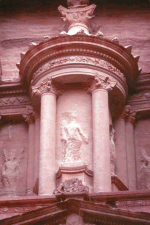 Then the siq opened to reveal the most majestic architectural site of the Nabateans: the Al-Khazneh Farun (Treasury of the Pharaoh), which is said to house the tomb of King Harith IV (84 BCE). This archeological monument, carved into rock, is considered one of the best-preserved sites in Jordan. Its name is derived from the urn, thought to have once been filled with gold and jewels, perched at the top of the building.
Then the siq opened to reveal the most majestic architectural site of the Nabateans: the Al-Khazneh Farun (Treasury of the Pharaoh), which is said to house the tomb of King Harith IV (84 BCE). This archeological monument, carved into rock, is considered one of the best-preserved sites in Jordan. Its name is derived from the urn, thought to have once been filled with gold and jewels, perched at the top of the building.
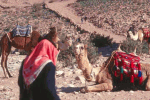 The click-clacking of hooves on the cobblestones of the siq interrupted my reverie. Hordes of tourists, arriving by bus and horse cart, invaded the ruins. I had serendipitously taken advantage of the fact that the gates of Petra open at 7 AM; tour companies don’t arrive until an hour later. I left the site to the others, but that hour of stillness had stayed with me especially since the Attack on America on 9/11.
The click-clacking of hooves on the cobblestones of the siq interrupted my reverie. Hordes of tourists, arriving by bus and horse cart, invaded the ruins. I had serendipitously taken advantage of the fact that the gates of Petra open at 7 AM; tour companies don’t arrive until an hour later. I left the site to the others, but that hour of stillness had stayed with me especially since the Attack on America on 9/11.
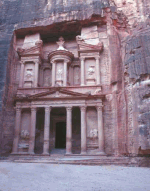 Little is known about the Nabateans who built Petra; they were thought to be Arab nomads who settled in this strategic location along the eastern ridge of the Great Rift Valley. During the first century BCE and into the first century CE, the Nabateans transported water from the Mediterranean and Red Sea, storing it in tanks (remains of which are still evident today). Accessibility to water also attracted camel caravans carrying spices, silk, and frankincense between China, India, and Arabia and Egypt and the Mediterranean. The city became an important stop on the Spice Route, with the bonus for caravans of the protection from enemies offered by the nearby mountains (probably a similar geography to that of the mountains of Afghanistan.) The Nabateans flourished, taxing trade goods in exchange for the water, hospitality, and safety of the city walls, using the profits to carve a city into the red rock cliffs.
Little is known about the Nabateans who built Petra; they were thought to be Arab nomads who settled in this strategic location along the eastern ridge of the Great Rift Valley. During the first century BCE and into the first century CE, the Nabateans transported water from the Mediterranean and Red Sea, storing it in tanks (remains of which are still evident today). Accessibility to water also attracted camel caravans carrying spices, silk, and frankincense between China, India, and Arabia and Egypt and the Mediterranean. The city became an important stop on the Spice Route, with the bonus for caravans of the protection from enemies offered by the nearby mountains (probably a similar geography to that of the mountains of Afghanistan.) The Nabateans flourished, taxing trade goods in exchange for the water, hospitality, and safety of the city walls, using the profits to carve a city into the red rock cliffs.
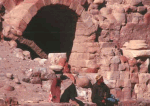 Later in the century, the Romans conquered the 3,000 inhabitants of Petra, and the architecture soon reflected the influx of Roman culture. In the sixth century, the Byzantines introduced Christianity, building, a number of churches. The demise of the Spice Route, due to a rise in shipping and a series of earthquakes, led to a slow decline for Petra.
Later in the century, the Romans conquered the 3,000 inhabitants of Petra, and the architecture soon reflected the influx of Roman culture. In the sixth century, the Byzantines introduced Christianity, building, a number of churches. The demise of the Spice Route, due to a rise in shipping and a series of earthquakes, led to a slow decline for Petra.
 The city rose again beginning in 1812. Having heard legends of the city during a visit to North Africa, Swiss explorer Johann Ludwig Burckhardt, who was fluent in Arabic, disguised himself as an Arab Muslim and hired a local guide to take him to Aaron’s tomb, which he knew to be in Petra, and where he said he wanted to sacrifice a goat. When the guide led him into the entry of the siq, Burckhardt, afraid to arouse suspicion from the guide, never passed beyond the spectacle of the Treasury. He did return, however, to share his discovery with the western world—bringing tourists to Petra to see one of the world’s top archeological sites.
The city rose again beginning in 1812. Having heard legends of the city during a visit to North Africa, Swiss explorer Johann Ludwig Burckhardt, who was fluent in Arabic, disguised himself as an Arab Muslim and hired a local guide to take him to Aaron’s tomb, which he knew to be in Petra, and where he said he wanted to sacrifice a goat. When the guide led him into the entry of the siq, Burckhardt, afraid to arouse suspicion from the guide, never passed beyond the spectacle of the Treasury. He did return, however, to share his discovery with the western world—bringing tourists to Petra to see one of the world’s top archeological sites.
 Visitors can spend days exploring Petra by foot or camel. Other major sites include an amphitheater, built by the Nabateans and enlarged by the Romans, that seats 8000 spectators. At the top of Attouf Ridge, two obelisks dominate the top of the High Place of Sacrifice. Tombs are scattered throughout the city; the most architecturally sophisticated is the Renaissance Tomb. Qsar Al-Bint, (Castle of the Pharaoh’s daughter), built in 40 BCE is the only remaining structure not carved into the steep rock of the Great Rift.
Visitors can spend days exploring Petra by foot or camel. Other major sites include an amphitheater, built by the Nabateans and enlarged by the Romans, that seats 8000 spectators. At the top of Attouf Ridge, two obelisks dominate the top of the High Place of Sacrifice. Tombs are scattered throughout the city; the most architecturally sophisticated is the Renaissance Tomb. Qsar Al-Bint, (Castle of the Pharaoh’s daughter), built in 40 BCE is the only remaining structure not carved into the steep rock of the Great Rift.
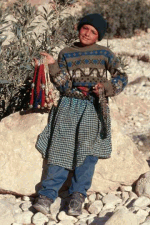 Daylight-hour restrictions close the hidden archeological site and limit the number of sites that can be explored in a day. As the gate to the archeological site closes at dusk, visitors must either be selective or allot several days to explore the ruins properly. Petra offers a number of hotels, most fairly basic by Western standards. The wise traveler will get an early start, reserving Petra’s treasures—especially the Al-Khazneh Farun— for the mystical morning hours.
Daylight-hour restrictions close the hidden archeological site and limit the number of sites that can be explored in a day. As the gate to the archeological site closes at dusk, visitors must either be selective or allot several days to explore the ruins properly. Petra offers a number of hotels, most fairly basic by Western standards. The wise traveler will get an early start, reserving Petra’s treasures—especially the Al-Khazneh Farun— for the mystical morning hours.
